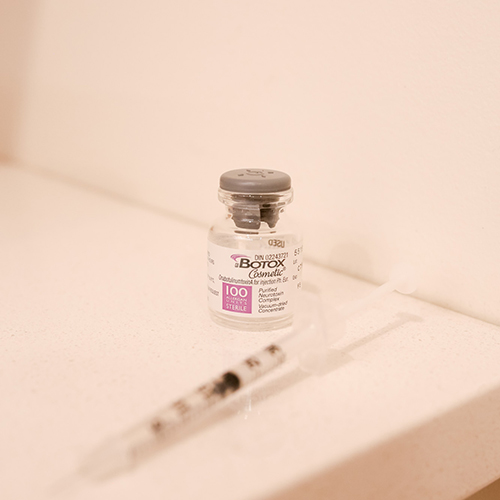Hyperhidrosis is a condition in which a person’s underarms, hands, and/or feet have overactive sweat glands. Sweating is a natural bodily function that maintains a healthy body temperature. Excessive sweating can cause a person to sweat through clothing despite wearing antiperspirant or lack of physical activity.
Get The Fact
After first trying and failing a topical Aluminum Chloride (Drysol®) treatment, you are eligible for a BOTOX® hyperhidrosis treatment.
BOTOX® works by blocking the chemical signal that initiates the activation of the sweat glands. BOTOX® can reduce up to 90% of sweating in the targeted area, and the most commonly treated areas are the axilla, hands, and feet. This treatment can be covered by your insurance.
A referral is not required for excessive sweating, call us to book a complimentary consultation.

Before you Arrive:
+ Please ensure you have filled out your Health History/Intake form before your appointment. If you are unable to complete it, please arrive 15 minutes early
+ We recommend eating a light snack or meal 30min- 1hr before your appointment
What to avoid:
+ Please avoid the following:
+ Alcohol for 24 hours before
+ Caffeine on the day of treatment
+ Aspirin or other non-steroidal anti-inflammatory drugs such as Ibuprofen, Advil®, Motrin®, Aleve®, Fish oil, Gingko Biloba, St. John’s Wort, and high doses of vitamin E, unless medically necessary
+ Is it our policy not to provide treatment if you are pregnant or breastfeeding
Downtime:
+ There is virtually no downtime after neuromodulator injections
+ You may have small red bumps at the injection site that will disappear within the hour
What to Avoid:
+ Please avoid the following:
+ Strenuous exercise for 24 hours
+ Laying down for 4 hours
+ Pressure to the treated areas (no hats on a treated forehead)
+ Facial massage or use of facial tools for 2 weeks
+ Makeup over the injection site for 24 hours
Follow Up:
+ Full results are at 2 weeks
+ You may require a follow-up appointment to tweak your result, this will be scheduled on the day of your treatment or you can call to book
+ No surgery required
+ Quick and easy injectable treatment
+ Improves quality of life
+ Often covered by third party insurance
+ Treatments are quick
Anyone who is 18 and older that has tried and failed a topical aluminum-based antiperspirant, such as Drysol.
In a clinical study, the majority of patients achieved a greater than 50% reduction in sweating, with many patients reporting up to 90% improvement in sweating.
In a clinical study, patients had drier underarms for up to 201 days or 6-7 months. Individual results may vary as our bodies metabolize BOTOX® differently, depending on stress levels and physical activity.
Common side effects of treatment are temporary bleeding, mild pain, swelling, and irritation at injection sites.
No. BOTOX® temporarily blocks chemical nerve signals that stimulate the sweat glands only where injected. When the sweat glands don’t receive the “message” to sweat, severe sweating is reduced to the treated area. Sweat will continue to be produced elsewhere, but there will be no compensatory sweating in other areas.
Many health insurance plans cover all or most of the treatment. There is also a reimbursement program available that provides coverage regardless of insurance status. For specific details on coverage, contact your insurance company and visit us for a complimentary consult to determine the course necessary for reimbursement.
Terms and conditions apply.
Follow our socials to stay up-to-date.